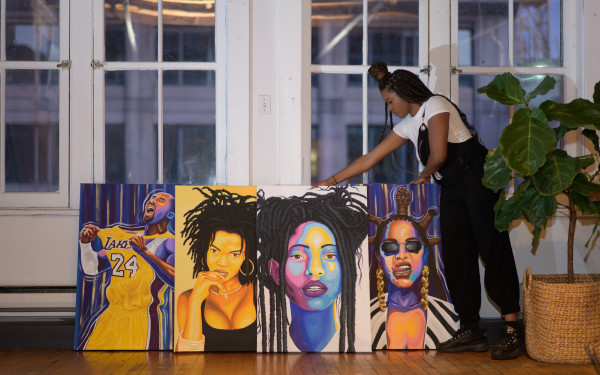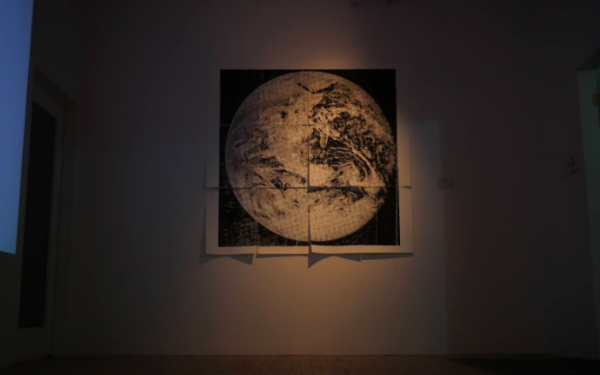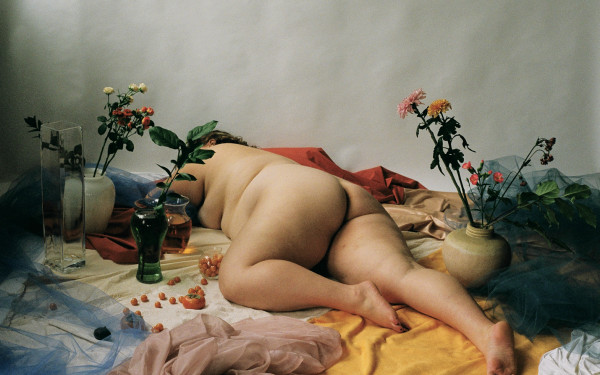Painter Whitney Montgomery presents solo exhibition of bold, emotional portraits
Concordia BFA student showcases paintings at Galerie Luz amidst pandemic
With Concordia’s studios closed by the pandemic, Fine Arts student Whitney Montgomery found studio space at Galerie Luz that led to a solo show.
The gallery owner and director, Luz Zapata, converted half of her gallery, located in the Belgo building, into space for an artist to work.
Montgomery became her first artist-in-residence this winter.
“I decided to have artists do a project within this space, [to have] an artist in residence,” Zapata said. “I [got] to see how much [Montgomery] could progress. I wasn’t thinking about a show immediately, because I didn’t know him, but I knew he had a good project.”
Zapata saw that he could do a show once she got to know him. “He was very prolific,” she said.
Montgomery’s paintings recontextualize imagery from old advertisements to create satire.
“I want it to be funny, in some sense, but also real,” he said.
Working with portraiture and text to highlight absurdities, he aims to elicit a falsely advertised utopia, drawing much of his inspiration from old magazines and archives.
“Nowadays you can look back and easily recognize absurdities in the past, but even talking about absurd happenings now, I think there’s a sadness to it,” he said. “I want to hit all emotions. It should be funny, it should be semi-serious, [with an] underlying sadness.”
Originally from Gananoque, Ontario, Montgomery moved to Montreal to pursue his BFA at Concordia. This show was his first solo show in the city. Before this, Montgomery has shown work at the Juried Art Salon in 2015, several exhibitions at the Heather Haynes Gallery, and at the annual Toronto Outdoor Art Fair in 2020.
Being the artist in residence at Galerie Luz allowed Montgomery the freedom to work on his paintings—which are part of an independent study for his final semester—without the constraints of projects or sharing studio spaces with his peers.
The theme of the show was satirizing certain political ideologies, like the “American dream.”
“It doesn’t have to be totally specific to the US, but this ideal "American dream" kind of lifestyle, in general, is what I’m interested in,” he said. “I use a lot of images from film and I feel like it comes from the idea of Hollywood romanticizing the past in certain ways.”
“[The idea] is taking the side of people who have views that I think are toxic in some way, and views that I disagree with […] but then these views are pushed to an extreme, and it’s ultimately ironic.”
Using portraiture allows Montgomery to better tell a story.
“Portrait and figurative painting has always been something I’m interested in because I found it complex and I like the challenge," he said. "[I’m] trying to master that kind of painting and realism, but in a way that’s not super detailed."
“Even if it’s not a straightforward narrative, having the emotion on the face can say a lot more instead of just painting out a full scene; it can be ambiguous, but still give off a feeling.” — Whitney Montgomery
“Even if it’s not a straightforward narrative, having the emotion on the face can say a lot more instead of just painting out a full scene; it can be ambiguous, but still give off a feeling.”
His favourite painting in the show is The Last Sips of Liberty, which was inspired by the Jan. 6 Capitol riots and the idea of “modern-day cowboys taking the last sips of liberty while the Trump administration is still in office.”
“I’ve been [implementing] text into my pieces, and I think that’s one of the most successful ways I’ve done it,” he said. “It’s still not totally taking away from the painting because the text is kind of hard to read, and it takes a while to understand what it’s saying, and what it’s getting at.”
“The first glance and the second glance, or reading of it, lets you see the painting of the subject, the cowboy, first, and the longer you look at it, it changes your experience.”
Through his clever use of text and bright colours, viewers can experience Montgomery’s paintings differently.
Upon first glance, the tantalizing colours draw attention to the paintings—but the words hold the gaze. Inspired by an old smoking advertisement, one canvas depicts two monochrome blue faces lighting cigarettes underneath the words "THE SMOG."
Another painting, which used to hang in Montgomery’s kitchen, pictures two people at what looks like a suburban pool party shadowed by a dark face—one of his housemates’. The face watches over their idyllic afternoon at the pool, representing the sinister undertones of true suburbia—denoted by the words “SUB-BURBIA” in bright, yellow letters.
Then, in a piece reading “TURN YOUR ISOLATION INTO A VACATION,” Montgomery’s subject—his father—holds a book with the words “FIVE TIPS ON HOW TO DEAL WITH YOURSELF.” Produced during the beginning of quarantine, it seems that Montgomery’s paintings—and dark humour—are tips for how to survive.
“I enjoy the idea of quickly seeing a painting and having one initial take and then looking at it, and you’re like, ‘Oh, this is what I thought was very bright and nice, bright colours, this calming thing,’ might be more ominous [the longer] you look at it.”
Montgomery’s art can be found at whitneymontgomeryart.com and @whitneymontgomeryartist on Instagram.


_600_832_s.png)



